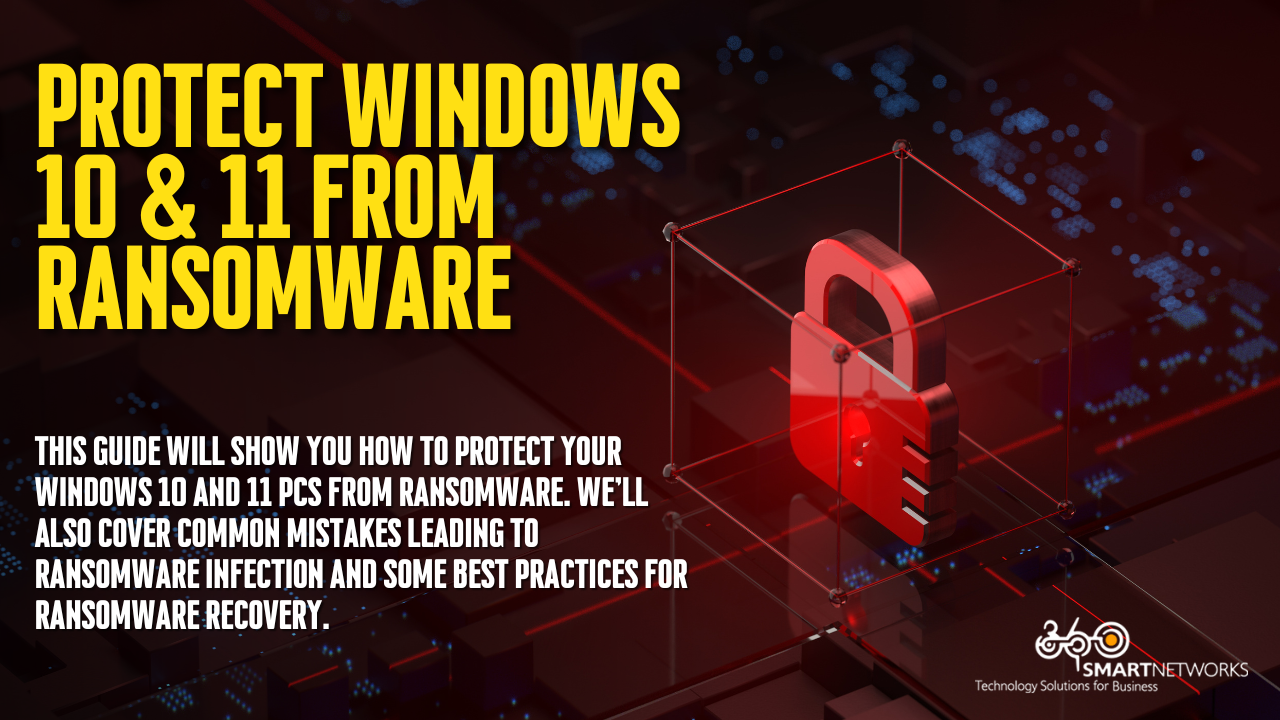Protect Windows 10 and Windows 11 Machines From Ransomware
REvil. GlobeImposter. DarkSide. PYSA. WannaCry. CryptoLocker. Ransomware threats and attacks are constantly evolving to evade detection, and the list of new families seems to grow daily. Ransomware groups are claiming victims of all sizes, from individuals to large enterprises. As ransomware groups continue to evolve their tactics, techniques, and procedures (TTPs), businesses must also evolve their defenses to stay ahead of the threat.
This guide will show you how to protect your Windows 10 and 11 PCs from ransomware. We’ll also cover common mistakes leading to ransomware infection and some best practices for ransomware recovery.
First, let’s take a look at how ransomware works and how it can spread through your organization.

What Is Ransomware?
Ransomware is malware that encrypts your files and keeps them until the requested ransom has been paid. The attackers will usually demand payment in cryptocurrency, such as Bitcoin, and the ransom amount can vary depending on the type of ransomware and the encrypted files. In some cases, the attackers may also threaten to release sensitive information, such as customer data, if the ransom is not paid.
Why Are Ransomware Attacks on the Rise?
There are a few reasons why ransomware attacks have been on the rise in recent years. First, the number of internet-connected devices has increased, which gives attackers more opportunities to infect devices with ransomware. The amount of data that organizations store has increased, giving attackers more incentive to target businesses with ransomware. Also, cryptocurrency has made it easier for attackers to receive payments without being traced.
5 Common Mistakes That Can Lead To Ransomware Infection
Ransomware is one of the biggest threats to businesses and individuals today. It can encrypt your files and demand a ransom for the decryption key, preventing you from accessing your own data. Ransomware can infect your PC through various methods, including email attachments, malicious websites, and drive-by downloads.
You can do several things to protect your PC from ransomware, but there are also some common mistakes that can lead to infection. Here are five of the most common mistakes that can leave you vulnerable to ransomware:
- Not keeping your operating system and software up to date: One of the most important things you can do to protect your PC from ransomware is to keep your operating system and software up to date. Outdated software is one of the most common ways ransomware can infect your PC, so it’s important to ensure you have the latest security patches installed.
- Not using an antivirus program: Another important way to protect your PC from ransomware is to use an antivirus program. Antivirus software can detect and remove malware, including ransomware, from your PC.
- Not backing up your data” If you don’t have a backup of your data, you could lose everything if your PC is infected with ransomware. Make sure you regularly back up your data to an external hard drive or online service.
- Clicking on links in email attachments: Email attachments are one of the most common ways ransomware is spread. If you receive an email attachment from an unknown sender, do not open it. Even if the attachment appears to be from a trusted sender, it could be infected with ransomware.
- Visiting malicious websites: Malicious websites are another common way ransomware can infect your PC. Avoid clicking on links in emails from unknown senders and only visit websites that you trust.
Identify and Overcome Weaknesses in Your Defenses
Ransomware attacks work well because they exploit common weaknesses in an organization’s security posture. The most common way ransomware is delivered is through email phishing, which takes advantage of user susceptibility to click on links or attachments from unknown senders. As a result, businesses must implement email security controls to protect against phishing attacks.
Additionally, businesses should educate their employees on the dangers of phishing emails and how to spot them. Another common way ransomware is delivered is through remote desktop protocol (RDP) brute force attacks. RDP is a legitimate tool that allows businesses to provide remote access to their systems. However, it can be abused by attackers who gain access to weak or easily guessed RDP credentials.
To protect against RDP brute force attacks, businesses should implement two-factor authentication for RDP. Additionally, businesses should consider disabling RDP if it’s not absolutely necessary. Finally, businesses should consider investing in a Next-Generation Anti-Virus (NGAV) solution. NGAV solutions are designed to stop ransomware and other advanced threats before they can cause damage.
Protecting Your Windows 10 and 11 Devices From Ransomware
Controlled Folder Access
Microsoft uses threat intelligence to protect Windows 10 and 11 devices from ransomware threats and attacks. Microsoft has an anti-ransomware tool directly built into Windows 10 and Windows 11 PCs that can detect and stop many types of ransomware.
Controlled folder access in Windows Security can help protect your data from ransomware and other threats. This feature prevents apps from making changes to files in certain protected folders. If an app that isn’t on the list of allowed apps tries to make a change to these files, Windows Security will block the app and alert you.
This feature is not automatically enabled on Windows 10 and 11, so you’ll need to turn it on. To do this, go to Start → Settings → Update & Security → Windows Security → Virus & Threat Protection. Under “Ransomware Protection,” select Manage settings and turn Controlled Folder Access on.
Update Windows
One of the best ways to protect your Windows 10 and 11 devices from ransomware is to update them with the latest security patches. By default, Windows 10 and 11 PCs are set to install updates automatically, but you can check to ensure this is turned on. To do this, go to Start → Settings → Update & Security → Windows Update and make sure the Install updates automatically option is turned on.
Backup Your Data
As we mentioned, one of the best ways to protect your data from ransomware is to regularly backup your files. If you are hit with a ransomware attack, you can recover your data from the backup and avoid paying the ransom. Once you have a solid backup in place, you can restore your files from the backup in the event of a ransomware attack. Regular backups also help protect your data in the event of hardware failure or other data loss incidents.
What Should You Do If Your Windows 10/11 PC Has Been Compromised?
If you think your Windows 10/11 PC might have been compromised, you should first disconnect it from the internet to prevent further infection. The team at 360 Smart Networks can then help you determine the best course of action, which may include backing up your data and reinstalling your operating system.
360 Smart Networks is here to help you protect your business from ransomware and other malware threats. From cloud backup services to comprehensive security solutions, we can help you keep your business safe. Contact us today to learn more about our services and how we can help you protect your business.
Subscribe To Our Blog

Make a Smart IT decision
Partner with 360 Smart Networks and receive:
- Reliable Outsourced IT services
- Bulletproof Cybersecurity
- Leading enterprise IT solutions






